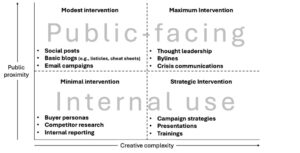The AI-Content Paradox
Is AI-augmented content creation only efficient when it’s inefficient?
Content marketers have found an uncanny ally in generative AI, which occupies an awkward place between accessory and partner. More than a tool that passively executes human commands, gen AI has the power to accelerate our creativity and productivity in incredible ways. The interaction feels collaborative, even conversational.
Although AI lacks many essential human qualities — chief among them intuition, judgment, and emotional intelligence — it’s no surprise the technology has found widespread purchase among marketers. A recent survey found that 63% of marketing professionals use generative AI in their work, with another 27% evaluating adoption within six months. Otherwise stated, nine in ten marketers either already use generative AI in their work or are considering doing so very soon.
Among those surveyed, content creation is the most cited use case for gen AI. Yet these marketers are also concerned about the quality of outputs (the second-highest barrier to AI adoption, narrowly outpaced by data privacy). So, marketers are keen to use AI to create content but worry the content produced simply isn’t good enough. Why use AI to create content if the quality isn’t there?
These are legitimate concerns. AI-generated content realizes lower engagement and conversion rates than content written by humans. By now, we’ve all begun to recognize the signifiers of AI-generated content — inauthentic copy, repetitive and jargony, overly polished and full of transition words. These pieces often require significant rework from marketers, so much in some cases that the efficiencies gained from AI are eroded or erased.
This negotiation, the tug-of-war between quality and efficiency, is and will remain central to the use of gen AI in content marketing. Even as tools become better and more specialized, human oversight will remain constant, and manual intervention will necessarily cut into efficiency to achieve the quality marketing teams desire.
Marketers need a strategic framework to gauge when and how to use gen AI in their work, one that predicts how much human intervention each AI-augmented task will require. Without this clarity, teams risk building cumbersome workflows that require more effort than simply doing it the old-fashioned way.
The AI-Content Intervention Matrix
The need for manual intervention in AI-augmented workflows increases proportionally along two lines: creative complexity and public proximity.
Creative complexity measures how much strategic thinking, unique insight, and creative problem-solving is necessary to complete the task. Compiling a research brief, for instance, is less creatively complex than writing a byline that expresses a CEO’s differentiated perspective. Public proximity considers how visible the output will be to external audiences — and therefore how much reputational risk it carries.
Charting these considerations along two axes, we can define four distinct quadrants, each requiring a different level of manual intervention:

- Minimal intervention applies to low-complexity, internal content like buyer personas and competitive analyses, for which AI can do the heavy lifting with human oversight.
- Moderate intervention covers straightforward, public-facing content like social media posts and basic blogs, such as listicles and cheat sheets. While AI can create a structure and provide a first draft, humans must refine copy and verify accuracy.
- Strategic intervention encompasses complex internal work like campaign strategies and presentations. AI supports research and ideation, with strategic and creative direction provided by humans.
- Maximum intervention covers high-stakes, public-facing content. AI serves as a research assistant and brainstorming partner, but humans supply differentiated insights and retain creative control.
Why It Works
Efficiency isn’t just about speed; it’s about resource allocation. The most efficient workflows, whether entirely human or bolstered by technology, produce quality outputs while minimizing wasted effort.
The AI-Content Intervention Matrix succeeds because it incorporates a truth many teams learn the hard way: that generative AI is not a panacea, but a tool that must be thoughtfully deployed. When marketers use AI for high-intervention tasks without proper planning, they risk expending more effort fixing problems than they would have by creating content from scratch. By mapping creative complexity against public proximity, teams can predict the level of intervention needs before starting projects, not after they’ve already invested hours creating subpar outputs.
Evolving Mindsets
As generative AI becomes more sophisticated, the temptation to use it everywhere will only grow. But efficiency without strategy has a low ceiling — too low to achieve the transformative promise of gen AI.
The future of content marketing isn’t human versus AI. It’s human with AI, deployed thoughtfully. This framework moves beyond the replacement mindset to a collaborative model. Instead of asking “Can AI do this?” marketers will ask, “How can AI help me do this better?”
